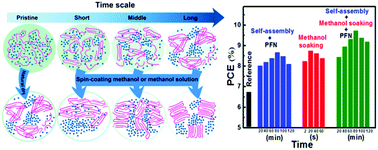Highly efficient polymer solar cells by step-by-step optimizing donor molecular packing and acceptor redistribution†
Abstract
The dynamic drying process of the active layer should play a vitally important role in determining the performance of polymer solar cells (PSCs). Donor molecular packing and acceptor redistribution can be optimized by two successive post-treatments on the active layer. The blend films were freshly prepared by spin-coating method and then immediately transferred to a covered glass Petri dish to allow self-assembly of the donor molecules. The films were then treated with methanol or PFN–methanol solution to adjust the acceptor redistribution. In this study, power conversion efficiencies (PCEs) of PSCs with PffBT4T-2OD:PC71BM as the active layer were improved from 6.74% to 8.75% by employing 80 min for self-assembly and 20 s of methanol soaking. The PCE was improved even further to 9.72% by inserting a PFN interfacial layer. The performance improvement was mainly attributed to the optimized PffBT4T-2OD molecular packing during the self-assembly process, ideal vertical phase separation driven by methanol soaking and efficient charge collection by insertion of a PFN interfacial layer. The molecular packing and vertical phase separation were characterized by grazing incidence X-ray diffraction (GIXD), transmission electron microscopy (TEM) and X-ray photoelectron spectroscopy (XPS), respectively. The experimental results solidly supported the effectiveness of the step-by-step optimization strategy.



 Please wait while we load your content...
Please wait while we load your content...